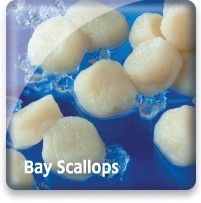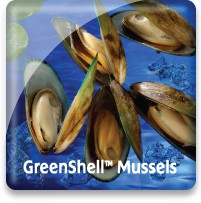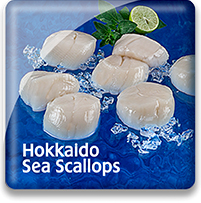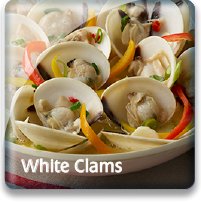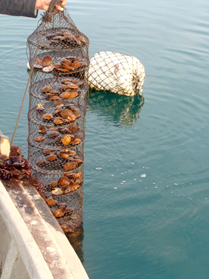
Bay Scallops

Market Name: Eating QualitiesBay Scallops are widely considered the best flavored and nicest scallop to eat. The meat of a Bay Scallop is creamy when raw, and upon cooking, becomes opaque. The meat is sweet, plump and possesses a near-firm texture.
Scallops are bivalves, meaning that they have two mirror image shells joined by a hinge.
|
Description & CharacteristicsBay Scallops are bi-valve mollusks. The part eaten is the abductor muscle; this is the cylindrical white meat that holds the two shells together. Bay Scallops are an important high-quality product and widely considered the best flavored of all scallops.Farmed Chinese Bay Scallops are raised along the shores of the Bohai Sea near Dalian in China. These Bay Scallops are harvested in the fall alive from their suspended structures called lanterns and shucked by hand on the beach or at the processing plant. The Bay Scallop, Argopecten irradians, a native of the U.S. East Coast was sent to China in the early 1980’s and has evolved into quite an aquaculture successful industry. In fact, the majority of Bay Scallops marketed in the U.S. are from China. Wild caught Philippine Bay Scallops are landed primarily in the southwestern region of Masbate. This Bay Scallop, Chlamys nobilis, is a different species than the Chinese farmed raised Bay Scallop. These scallops are diver caught or dredged and landed alive in the shell and shucked by hand on shore, usually by the fishermen. Philippine Bay Scallop fishing starts in the fall, and although in most places it is allowed until the following May, many fishermen find the catches unrewarding after the first two or three months. Landings thus drop to a trickle by the turn of the year and the onset of the coldest weather. Peru scallops are produced from both aquaculture and extensive seeding programs that produce scallops that are considered to be wild harvested. Most of the farm-raised scallops come from the southern region of Peru and use the suspended Chinese lantern technique of culturing. Both hatchery and wild scallop seeds are used to stock the farms. Most of the wild caught scallop fishery takes place in the northern region. This fishery consists of both natural and enhanced stocks. Enhanced scallop stocks are created by distributing scallops seeds from hatcheries or by relocating natural seeds from other areas. Enhanced stocks are considered to be part of the wild caught fishery. This wild fishery is harvested by individual divers that pose little threat to other species or the benthic habitat. Scallops marketed in the U.S. are commonly processed in phosphate dips in order to restore the water content found naturally as well as to help whiten the scallop—generally considered a consumer preference. Scallops naturally retain water, and the addition of phosphates helps the meats to hold this water. However, excessive treatment with phosphates can cause the Bay Scallop meat to lose its natural flavors. The use of phosphate dips or other additives must be noted on the label. Scallops in the U.S. are marketed as either processed or dry (non-treated and less than 82% moisture content). Bay Scallops are graded by the number of scallops per pound; 40/60, 60/80, 80/100, 80/120, 120/150 and 150/200. Other Resources
|
Handling Instructions for Bay Scallop
Frozen bay scallops should be stored at or below 0°F (-18°C) and then thawed properly when ready to cook. Frozen shelf life is 18 months. Links to proper seafood handling instructions: NOAA - Fish Watch: Handling Seafood and A Consumer Guide to Safe Seafood Handling.
Thawing Bay Scallop
Bay scallops should be thawed by removing them from their package and placing them in a sealed plastic bag or container and placed in the refrigerator (33 to 39°F) for 12 to 24 hours or until completely thawed. IQF bay scallops can also be placed in a colander and rinsed under cold water to remove any ice glazing and then immediately cooked from this still frozen or partially frozen state. Bay scallops not consumed immediately after complete thawing need to be refrigerated between 33 and 39°F and consumed within 2-3 days.
Important Instructions for Bay Scallop
Upon complete thawing, gently remove the scallops from any milky colored natural scallop juices that have seeped from the scallops during thawing. This weeping of juices is perfectly normal. Because bay scallops are small and cook quickly, they can many times be cooked directly from the frozen state when added to soups or casseroles. Raw bay scallops that are cooked immediately after thawing or cooked directly from the frozen state will yield the best quality.
Cooking Tips
Raw bay scallop are quick and easy to cook in as little as 3-7 minutes by either baking, steaming, boiling, broiling, barbecuing or pan frying. Bay scallops are delicate in texture and taste and should not be overcooked or they may become rubbery and lose flavor. Cooking raw bay scallops directly from the frozen state works well to help preserve their natural flavors and is appropriate under certain cooking preparations such as for soups and casseroles that require longer cooking times at lower temperatures. Link to bay scallop cooking tips and recipes.
The Philippines
The Republic of the Philippines is actually an archipelago, or group of islands set in the middle of the Pacific Ocean and the South China Sea. Roughly the size of Italy, this island nation boasts more than 10,849 miles. Its fishery is divided into marine, inland, and aquaculture.
Commercial species include scad, tuna (yellowfin and skipjack), mackerel, anchovies, sardines, squid, and blue crab. Aquaculture originally started in the Philippines with the cultivation of “Milkfish” – which took place in brackish water ponds originally, extending later to net cages floating in both fresh water and marine environments.
Shrimp is another major product of the Philippines, starting with Black Tiger prawns, largely exported to Japan. Shrimp underwent a “boom and bust” cycle, because of disease problems that led to a decline in production.
Today, finfish is becoming a popular aquaculture species, particularly Tilapia, some carp; seaweed, oysters and mussels.
China
With more than 1.3 billion people, China is today the world’s most populous country. With a growing economy fueling an appetite for seafood, China has begun importing seafood for in-country consumption, as well as exporting a great deal of its production. In fact, since 2002, China has continued to export more fish and fishery products than any other country in the world, with Japan, the United States, and the Republic of Korea as its main export markets.
Chinese distant water fishing activities started in 1985 when China gained access to new fishing grounds through agreements with foreign countries. China operates vessels in West Africa, the North Pacific, and tuna longline vessels in the South Pacific. In addition, squid are harvested in the Japan Sea, the South Atlantic, and the North Pacific under Chinese-flagged vessels.
Carp are also commercially important, as are bream, shad, eel, catfish, rainbow trout, salmon, whitebait, mullet, mandarin fish, perch, sturgeon, and murrel (snakehead). Commercial shellfish include Saltwater & freshwater shrimp, river crabs, and mollusks such as mussels, clams, oysters, and freshwater snails.
With one-fifth of the world’s population, and an official government policy to promote aquaculture, China has today become an aquaculture powerhouse, now producing more than two-thirds of the world’s aquaculture species. Fish and shellfish are grown in freshwater and saltwater environments.
Peru
Peru is located along the west coast of the South American Continent just below the equator. Peru has over 14,000 miles of coastline. Peru is rich in natural resources and foreign trade is dominated by the export of raw materials. In terms of export value, gold and copper are the most important economic export goods followed by fisheries products.
Peru’s fishing industry became a prominent part of the country’s economy during the 1950s when industrialized fishing expanded the anchovy fishery. Today Peru is one of the largest fishing nations in the world accounting for approximately ten percent of the global wild fishery landings. The cold-water Humboldt Current brings nutrient-rich cold waters to the coast of Peru that create ideal fishing grounds for large pelagic schools of anchovies and other species. The Peruvian anchovy is the world's largest single species fishery measured by volume. This species is also the main raw material for the fishmeal and fish oil industry, which is the largest industry within the fishery sector in Peru. However, anchovies are not the only commercial species; Giant squid, Shrimp, Scallops, and various finfish are growing components.
Peru’s National Plan for Aquaculture Development is also expanding both freshwater and marine aquaculture in this rapidly developing nation. Fishery exports currently account for approximately 30% of all exports. Peruvian scallop exports to the United States are growing part of this. Most Peru scallops are produced primarily from aquaculture in the southern waters and from a wild fishery in the northern waters which has been augmented by extensive seeding programs. In order for Peru’s seafood industry to sustain its growth, responsible wild fishery and aquaculture best practices must be expanded and constantly improved.
|
|
Go Blue! Seafood Sustainability Spectrum
*Click here for an explanation of our Sustainability Spectrum
Sustainability AssessmentSea Port currently imports farm-raised Bay Scallops from China and wild caught noble scallops from the Philippines and Peru. Scallop aquaculture, as with other types of bivalve culture, generally has minimal environmental impacts. Scallops are filter feeders—they feed by removing small particles, such as plankton and other nutrients, from the water column—which means that scallop farming does not require supplemental feed and can actually improve local water quality. However, this low environmental impact requires that farms are appropriately sited; that stocking densities do not exceed the ability of the environment to handle waste from the scallops; and that best management practices are used to manage disease. Farms also need to take steps to minimize negative effects that may result from harvest methods, predator control, and the use of wild as well as hatchery-raised seed. Farmed Chinese Bay Scallops that are farmed off the ocean floor in cages are currently listed as “best choice” by Monterey Bay Aquarium's Seafood Watch. Sea Port sources their scallops from Chinese farms employing the off the bottom growing technique. Sea Port also imports wild noble scallops from the Philippines and bay scallops from Peru. The Philippine wild noble scallop fishery season and catch size restrictions are established and regulated by the Philippine Bureau of Fisheries and Aquatic Resources. The enforcement, however, is handled by local fishers and municipalities and at this time this wild fishery is considered to be sustainable by Sea Port’s Philippine suppliers. The Peru wild scallops fishery has management regulations in place that control catch size, but this is poorly enforced. In additon, there are few efforts to further manage the fishery regarding limited entry, annual catch limits, or strict fishing seasons. The wild Peru scallops fishery is generally considered a boom or bust fishery that is dependent upon climatic conditions such as the occurrence of El Nino. During El Nino years, the scallop fishery increases in abundance and is historically fished down rapidly. Some efforts are being made to close certain areas that exhibit overfishing, but adequate enforcement is lacking. The Peru scallop fishery is conducted by divers that pose little threat to other species or to the benthic habitat. 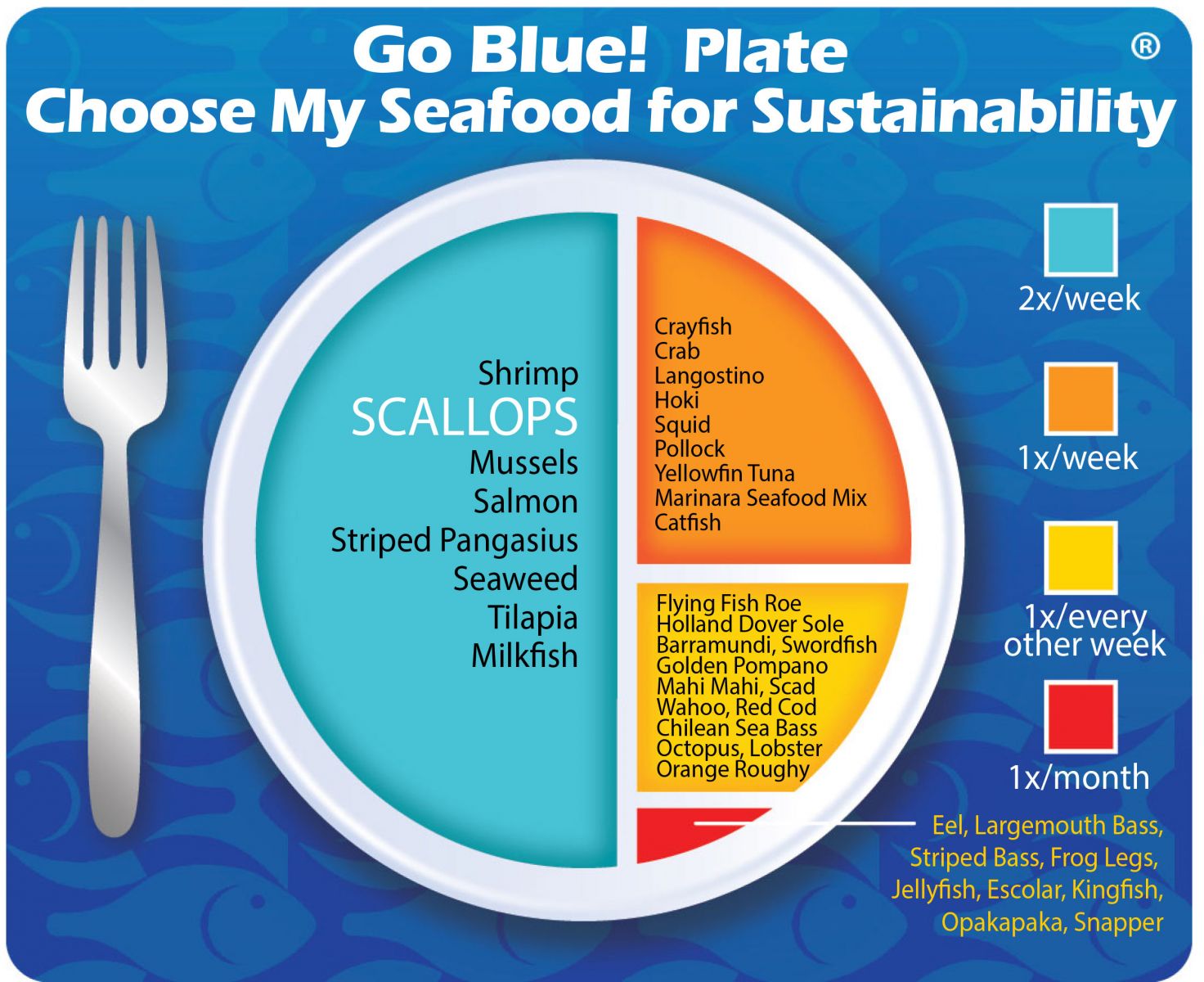
Environmental Impact: LowScallop farms, if properly sited and managed, can operate with relatively small impacts on the surrounding environment and can actually improve local water quality and properly managed wild scallop fisheries can be sustainable.
Sustainability Improvements NeededMore information is needed about scallop culture and wild fisheries in some countries and regions to ensure adverse environmental impacts are prevented or minimized. Enforcement of existing fishing regulations is needed in both the Philippines and in Peru.
Actions that Sea Port is UndertakingSea Port is aggressively marketing all our farmed and wild scallops. Sea Port believes that increasing the overall consumption of bivalve mollusks (lower trophic level seafood) will further the protection of our aquatic environments while providing sustainably produced proteins for future generations. Sea Port is a Governing Member of the Global Aquaculture Alliance and as such has helped support the advancement of sustainable bivalve mollusk aquaculture. Sea Port believes that, in aggregate, choosing from a diverse variety of seafood is better for sustaining the world’s seafood resources and farmed and wild Bay Scallops should be a part of this variety.
We created the sustainability assessments for each of our seafood items in order to reveal the existing and potential environmental impacts and risks that are associated with producing them for human consumption. This allowed us to establish the starting position for each of our seafood items along our progressive Go Blue! Seafood Sustainability Spectrum®. These assessments are only a single snapshot in time and because of this, we will continue to assess and update the critical sustainability needs associated with our supply sources and issue updates to the Go Blue! Seafood Sustainability Spectrum® as needed. There is a growing global awareness for the need to assure the sustainability of farmed and wild caught seafood and because of this; all around the world positive changes are rapidly occurring at all levels of the seafood supply chain. We will continue to spread this growing awareness and work with our many industry partners to improve the sustainability of all seafood, which we believe is the ideal protein of choice to feed an ever growing world population. Our Go Blue! Seafood Sustainability Spectrum® serves as our compass and yardstick as we strive to move all our products forward to becoming more sustainable. Please join us in this committed quest and Catch Our Wave® to sustainability by choosing a diverse variety of responsibly produced seafood as part of your diet.
|


